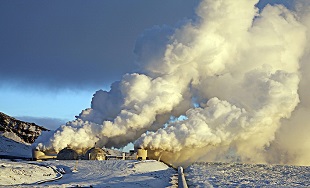Geothermal energy in Iceland
Iceland is one of the most dynamic volcanic regions in the world. Shaped by fierce natural forces, straddling the Mid-Atlantic Ridge where the activity of divergent tectonic plates brings heat and magma closer to the earth´s surface, Iceland holds enormous geothermal resources.
Because of its singular geological position, Iceland has the special conditions needed to generate geothermal energy. The high degree of volcanism, along with the world renowned expertise of Icelandic specialists in the field of geothermal energy utilization, enables Iceland to be the world leader the production of this eco-friendly, sustainable and renewable power.
Geothermal energy in Iceland is used in diverse ways, including being harnessed for heating and the production of electricity. The energy comes rather cheap. So, in the wintertime, some sidewalks in Reykjavík (Reykjavik) and Akureyri are heated, and on the 40 km long road between Reykjavik and the International Airport at Keflavík (Keflavik), the lights on the lamp posts are on the whole night.
Geothermal power plants
Nesjavellir Power Plant, located at 177 m (581ft.) above sea level on the northeast side of Hengill, supplies 1,100 l/sec of 82-85°C hot water (181.4ºF). The water travels through a 27 km long pipeline (16.78 miles) to the city with a heat loss of only 2°C on the way. It is a combined heat and power plant and provides space heating and hot water for most of the Greater Reykjavik Area. It is the most powerful geothermal well in the world.
First boreholes for the plant were drilled in 1965. Before that, some greenhouses had utilized the warmth in the area. The deepest hole was 836 m (0.5 miles). Since then, 25 boreholes have been drilled, 1 000-2 200 m deep, and 13 of them are utilized today. The deepest borehole is 2 265 m (1.4 miles). Each hole provides 20-50 kg of water and steam per second; steam is normally half or more. One of the hottest holes had water up to 400°C (XF) at the depth of 2 km (1.243 miles), proving too much for the plant to handle. It was filled up with gravel and is now 1 580 m (0.932 miles) deep, but still one of the most powerful holes. Each borehole provides 50 MW of usable warmth. Only the warmth is used to heat cold water which is then piped towards Reykjavik.
 In Iceland, several major geothermal power plants produce around 30% of the country's electricity. In addition, geothermal heating meets the heating and hot water requirements of around 87% of the nation´s housing. Some of the plants listed below produce both electricity and hot-water for heating purposes; others only electricity.
In Iceland, several major geothermal power plants produce around 30% of the country's electricity. In addition, geothermal heating meets the heating and hot water requirements of around 87% of the nation´s housing. Some of the plants listed below produce both electricity and hot-water for heating purposes; others only electricity.
Svartsengi Power Plant is situated in the south-west of the country, near the International Airport at Keflavik on the Reykjanes peninsula. As of 2012, it produces 75 MWe of electricity, and about 475 litres per second of almost boiling water (90°C). The water is also used to heat up the lake of the nearby Bláa Lónið (The Blue Lagoon).
Krafla Power Plant is situated in the north-east corner of Iceland, near Lake Mývatn (Myvatn) and the volcano Krafla, from which it gets its name. It produces 60 MWe of electricity, with an expansion to 90 MWe planned.
Hellisheidi Power Plant is located at Hengill, 11 km (7 miles) from the Nesjavellir Geothermal Power Plant. As of Oct 2011, the plant has a capacity of 303 MW of electricity and 133 MW of hot water; target capacity is 400 MW.
Reykjanes Power Plant, located on the Reykjanes peninsula (15 km west of the Svartsengi Power Plant), produces 100 MWe, 850 GWhe/year, using steam from a reservoir at 290-320ºC. This is the first time that geothermal steam of such high temperature has been used to generate electricity on a large scale, and currently it's the only high-temperature seawater-recharged geothermal system on a mid-ocean-ridge available for deep drilling anywhere in the world.